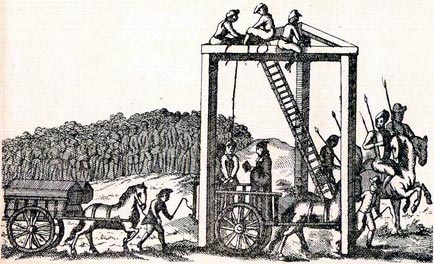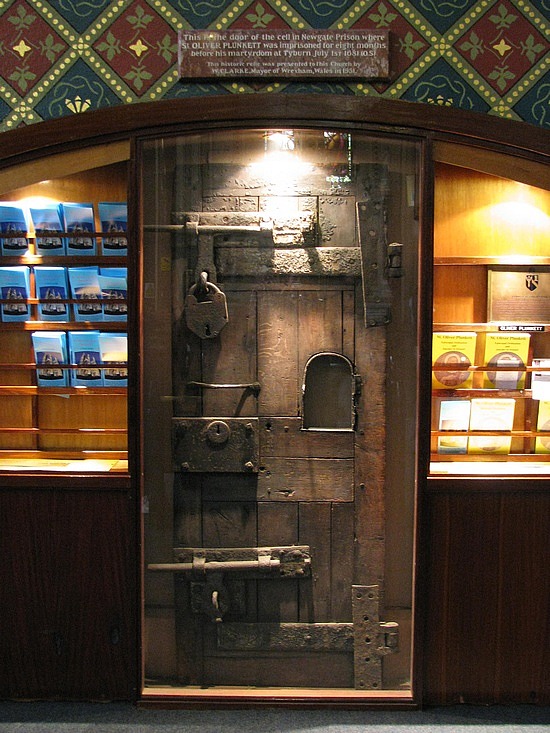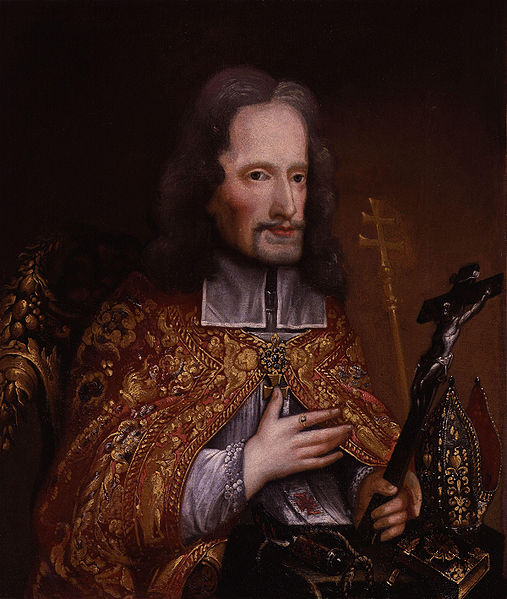Saint Oliver Plunket
Archbishop of Armagh and Primate of all Ireland, born at Loughcrew near Oldcastle, County Meath, Ireland, 1629; died 11 July, 1681. His is the brightest name in the Irish Church throughout the whole period of persecution. He was connected by birth with the families which had just then been ennobled, the Earls of Roscommon and Fingall, as well as with Lords Louth and Dunsany. Till his sixteenth year, his education was attended to by Patrick Plunket, Abbot of St. Mary’s, Dublin, brother of the first Earl of Fingall, afterwards bishop, successively, of Ardagh and Meath. He witnessed the first triumphs of the Irish Confederates, and, as an aspirant to the priesthood, set out for Rome in 1645, under the care of Father Scarampo, of the Roman Oratory.
As a student of the Irish College of Rome, which some twenty years before had been founded by Cardinal Ludovisi, his record was particularly brilliant. The Rector, in after years, attested that he “devoted himself with such ardor to philosophy, theology, and mathematics, that in the Roman College of the Society of Jesus he was justly ranked amongst the foremost in talent, diligence, and progress in his studies, and he pursued with abundant fruit the course of civil and canon law at the Roman Sapienza, and everywhere, at all times, was a model of gentleness, integrity, and piety”. Promoted to the priesthood in 1654, Dr. Plunket was deputed by the Irish bishops to act as their representative in Rome. Throughout the period of the Cromwellian usurpation and the first years of Charles II’s reign he most effectually pleaded the cause of the suffering Church, whilst at the same time he discharged the duties of theological professor at the College of Propaganda. In the Congregation of Propaganda, 9 July, 1669, he was appointed to the primatial see of Armagh, and was consecrated, 30 Nov., at Ghent, in Belgium, by the Bishop of Ghent, assisted by the Bishop of Ferns and another bishop. The pallium was granted him in Consistory 28 July, 1670.
Dr. Plunket lingered for some time in London, using his influence to mitigate the rigor of the administration of the anti-Catholic laws in Ireland, and it was only in the middle of March, 1670, that he entered on his apostolate in Armagh. From the very outset he was most zealous in the exercise of the sacred ministry. Within three months he had administered the Sacrament of Confirmation to about 10,000 of the faithful, some of them being sixty years old, and, writing to Rome in December, 1673, he was able to announce that “during the past four years”, he had confirmed no fewer that 48,655 people. To bring this sacrament within the reach of the suffering faithful he had to undergo the severest hardships, often with no other food than a little oaten bread; he had to seek out their abodes on the mountains and in the woods, and as a rule, it was under the broad canopy of heaven that the Sacrament was administered, both flock and pastor being exposed to the wind and rain. He made extraordinary efforts to bring the blessings of education within the reach of the Catholic youth. In effecting this during the short interval of peace that marked the beginning of his episcopate his efforts were most successful. He often refers in his letters to the high school which he opened at Drogheda, at this time the second city in the kingdom. He invited Jesuit Fathers from Rome to take charge of it, and very soon it had one hundred and fifty boys on the roll, of whom no fewer than forty were sons of the Protestant gentry. He held frequent ordinations, celebrated two Provincial Synods, and was untiring in rooting out abuses and promoting piety.

The shrine of St. Oliver Plunkett at St. Peter’s Roman Catholic Church, Drogheda, Ireland. The martyr’s head is visible in the box under the spire.
One incident of his episcopate merits special mention: there was a considerable number of so-called Tories scattered through the province of Ulster, most of whom had been despoiled of their property under the Act of Settlement. They banded themselves together in the shelter of the mountain fastnesses and, as outlaws, lived by the plunder of those around them. Anyone who sheltered them incurred the penalty of death from the Government, anyone who refused them such shelter met with death at their hands. Dr. Plunket, with the sanction of the Lord Lieutenant, went in search of them, not without great risk, and reasoning with them in a kind and paternal manner induced them to renounce their career of plundering. He moreover obtained pardons for them so that they were able to transfer themselves to other countries, and thus peace was restored throughout the whole province. The contemporary Archbishop of Cashel, Dr. Brennan, who was the constant companion of Dr. Plunket, in a few words sketches the fruitful zeal of the primate: “During the twelve years of his residence here he proved himself vigilant, zealous, and indefatigable, nor do we find, within the memory of those of the present century, that any primate or metropolitan visited his diocese and province with such solicitude and pastoral zeal as he did,—benefiting, as far as was in his power, the needy; wherefore he was applauded and honored by both clergy and people”.
The storm of persecution burst with renewed fury on the Irish Church in 1673; the schools were scattered, the chapels were closed. Dr. Plunket, however, would not forsake his flock. His palace thenceforward was some thatched hut in a remote part of his diocese. As a rule, in company with the Archbishop of Cashel, he lay concealed in the woods or on the mountains, and with such scanty shelter that through the roof they could at night count the stars of the sky. He tells their hardship in one of his letters: “The snow fell heavily, mixed with hailstones, which were very large and hard. A cutting north wind blew in our faces, and snow and hail beat so dreadfully in our eyes that up to the present we have scarcely been able to see with them. Often we were in danger in the valleys of being lost and suffocated in the snow, till at length we arrived at the house of a reduced gentleman who had nothing to lose. But, for our misfortune, he had a stranger in his house by whom we did not wish to be recognized, hence we were placed in a garret without chimney, and without fire, where we have been for the past eight days. May it redound to the glory of God, the salvation of our souls, and of the flock entrusted to our charge”.
Writs for the arrest of Dr. Plunket were repeatedly issued by the Government. At length he was seized and cast into prison in Dublin Castle, 6 Dec., 1679, and a whole host of perjured informers were at hand to swear his life away. In Ireland the character of those witnesses was well known and no jury would listen to their perjured tales, but in London it was not so, and accordingly his trial was transferred to London. In fact, the Shaftesbury Conspiracy against the Catholics in England could not be sustained without the supposition that a rebellion was being organized in Ireland. The primate would, of course, be at the head of such a rebellion. His visits to the Tories of Ulster were now set forth as part and parcel of such a rebellion. A French or Spanish fleet was chartered by him to land an army at Carlingford Bay, and other such accusations were laid to his charge. But there was no secret as to the fact that his being a Catholic bishop was his real crime. Lord Brougham in “Lives of the Chief Justices of England” brands Chief Justice Pemberton, who presided at the trial of Dr. Plunket, as betraying the cause of justice and bringing disgrace on the English Bar. This Chief Justice set forth from the bench that there could be no greater crime than to endeavor to propagate the Catholic Faith, “than which (he declared) there is not anything more displeasing to God or more pernicious to mankind in the world”. Sentence of death was pronounced as a matter of course, to which the primate replied in a joyous and emphatic voice: : “Deo Gratias”.

This is an illustration, said to be from about 1680, of the permanent gallows at Tyburn, which once stood where Marble Arch now stands. There was a three-mile cart ride in public from Newgate prison to the gallows, with large spectator stands lined along the way, so many people could see the hangings (for a fee). Huge crowds collected on the way and followed the accused to Tyburn.
On Friday, 11 July (old style the 1st), 1681, Dr. Plunket, surrounded by a numerous guard of military, was led to Tyburn for execution. Vast crowds assembled along the route and at Tyburn. As Dr. Brennan, Archbishop of Cashel, in an official letter to Propaganda, attests, all were edified and filled with admiration, “because he displayed such a serenity of countenance, such a tranquility of mind and elevation of soul, that he seemed rather a spouse hastening to the nuptial feast, than a culprit led forth to the scaffold”. From the scaffold he delivered a discourse worthy of an apostle and martyr. An eye-witness of the execution declared that by his discourse and by his heroism in death he gave more glory to religion than he could have won for it by many years of a fruitful apostolate. His remains were gathered with loving care and interred apart in St. Giles’ churchyard. In the first months of 1684 they were transferred to the Benedictine monastery at Lambspring in Germany, whence after 200 years they were with due veneration translated and enshrined in St. Gregory’s College, Downside, England. The head, in excellent preservation, was from the first enshrined apart, and since 1722 has been in the care of the Dominican Nuns at their Siena Convent at Drogheda, Ireland. Pilgrims come from all parts of Ireland and from distant countries to venerate this relic of the glorious martyr, and many miracles are recorded.

The prison door of St. Oliver Plunkett from Dublin Castle, located at the Shrine of St. Oliver in Ireland. photo by emmafox
The name of Archbishop Plunket appears on the list of the 264 heroic servants of God who shed their blood for the Catholic Faith in England in the sixteenth and seventeenth centuries, which was officially submitted for approval to the Holy See, and for which the Decree was signed by Leo XIII 9 Dec., 1886, authorizing their Cause of Beatification to be submitted to the Congregation of Rites. The Blessed Oliver Plunket’s martyrdom closed the long series of deaths for the faith, at Tyburn. The very next day after his execution, the bubble of conspiracy burst. Lord Shaftesbury, the chief instigator of the persecution, was consigned to the Tower, and his chief perjured witness Titus Oates was thrown into jail. For a few years the blessings of comparative peace were restored to the Church of Ireland.
The Martyr’s discourse at Tyburn was repeatedly printed and translated into other languages. Dr. Plunket published in 1672 a small octavo of fifty-six pages with the title “Jus Primatiale”; or the Ancient Pre-eminence of the See of Armagh above all other archbishoprics in the kingdom of Ireland, asserted by “O.A.T.H.P.”, which initials represent “Oliverus Armacanus Totius Hiberniae Primas”, i.e. “Oliver of Armagh, Primate of All Ireland”.
[ed. note: St. Oliver Plunkett was canonized by Pope Paul VI on October 10, 1975]Patrick Francis Cardinal Moran (Catholic Encyclopedia)










